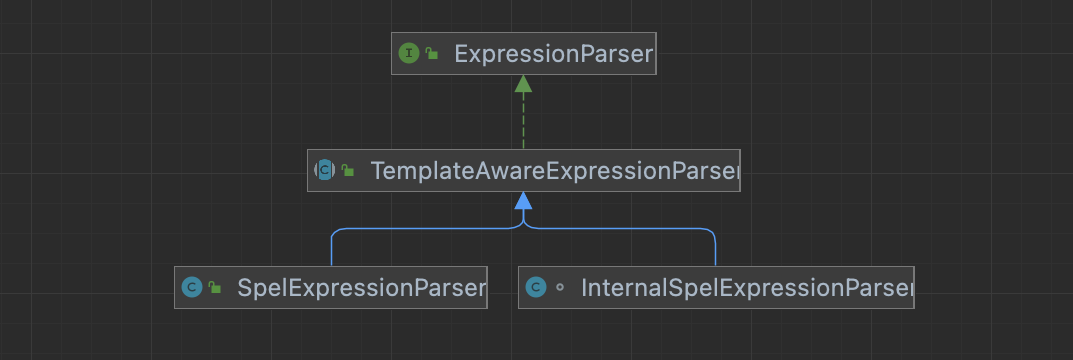第05篇:SpEL强大的表达式语言

公众号: 西魏陶渊明
CSDN: https://springlearn.blog.csdn.net (opens new window)
天下代码一大抄, 抄来抄去有提高, 看你会抄不会抄!

# 一、概述
Spring 表达式语言(简称“SpEL”)是一种强大的表达式语言,支持在运行时查询和操作对象图。语言语法类似于 Unified EL,但提供了额外的功能,最值得注意的是方法调用和基本的字符串模板功能。
虽然还有其他几种可用的 Java 表达式语言——OGNL、MVEL 和 JBoss EL 等等
但创建 Spring 表达式语言的目的是为 Spring 社区提供一种可在所有产品中使用的受良好支持的表达式语言。它的语言特性由 Spring 产品组合中的项目需求驱动。
# 二、作用
# 2.1 基本表达式
字面量表达式、关系,逻辑与算数运算表达式、字符串连接及截取表达式、三目运算、正则表达式、括号优先级表达式;
# 2.2 类相关表达式
类类型表达式、类实例化、instanceof表达式、变量定义及引用、赋值表达式、自定义函数、对象属性存取及安全导航表达式、对象方法调用、Bean引用;
# 2.3 集合相关表达式
内联List、内联数组、集合,字典访问、列表,字典,数组修改、集合投影、集合选择;不支持多维内联数组初始化;不支持内联字典定义;
# 2.4 其他表达式
模板表达式。
# 三、主要类
# 3.1 ExpressionParser

表达式解析器接口,包含了(Expression) parseExpression(String), (Expression) parseExpression(String, ParserContext)两个接口方法。
public interface ExpressionParser {
/**
* 解析表达式字符串并返回一个可用于重复评估的表达式对象。
*/
Expression parseExpression(String expressionString) throws ParseException;
/**
* 解析表达式字符串并返回一个可用于重复评估的表达式对象。
* context -- 用于影响此表达式解析例程的上下文(可选)
*/
Expression parseExpression(String expressionString, ParserContext context) throws ParseException;
}
2
3
4
5
6
7
8
9
10
11
12
13
14
# 3.2 ParserContext
解析器上下文接口,主要是对解析器Token的抽象类,包含3个方法:getExpressionPrefix,getExpressionSuffix和isTemplate,就是表示表达式从什么符号开始什么符号结束,是否是作为模板(包含字面量和表达式)解析。
public interface ParserContext {
/**
* 被解析的表达式是否是模板
*/
boolean isTemplate();
/**
* 对于模板表达式,返回标识字符串中表达式块开始的前缀。例如:“${”
*/
String getExpressionPrefix();
/**
* 对于模板表达式,返回标识字符串中表达式块结尾的前缀。例如: ”}”
*/
String getExpressionSuffix();
}
2
3
4
5
6
7
8
9
10
11
12
13
14
15
16
17
18
# 3.3 Expression
表达式的抽象,是经过解析后的字符串表达式的形式表示。通过expressionInstance.getValue方法,可以获取表示式的值。也可以通过调用getValue(EvaluationContext),从评估(evaluation)上下文中获取表达式对于当前上下文的值
public interface Expression {
/**
* 返回用于创建此表达式的原始字符串(未修改)
*/
String getExpressionString();
/**
* 在默认的标准上下文中计算这个表达式。
*/
@Nullable
Object getValue() throws EvaluationException;
/**
* 在默认上下文中计算表达式。如果评估的结果与预期的结果类型不匹配,则将返回异常。
*/
@Nullable
<T> T getValue(@Nullable Class<T> desiredResultType) throws EvaluationException;
/**
* 针对指定的根对象评估此表达式。
*/
@Nullable
Object getValue(Object rootObject) throws EvaluationException;
/**
* 针对指定的根对象评估此表达式。结果与预期的结果类型不匹配,则将返回异常。
*/
@Nullable
<T> T getValue(Object rootObject, @Nullable Class<T> desiredResultType) throws EvaluationException;
/**
* 在提供的上下文中评估此表达式并返回评估结果。
*/
@Nullable
Object getValue(EvaluationContext context) throws EvaluationException;
/**
* 在提供的上下文中评估此表达式并返回评估结果。但提供的根上下文会覆盖,默认的上下文
*/
@Nullable
Object getValue(EvaluationContext context, Object rootObject) throws EvaluationException;
/**
* 在指定的上下文中评估表达式,该上下文可以解析对属性、方法、类型等的引用。评估结果的类型应为特定类,如果不是且无法转换为该类,将引发异常类型
*/
@Nullable
<T> T getValue(EvaluationContext context, @Nullable Class<T> desiredResultType) throws EvaluationException;
/**
* 在指定的上下文中评估表达式,该上下文可以解析对属性、方法、类型等的引用。评估结果的类型应为特定类,如果不是且无法转换为该类,将引发异常类型。提供的根对象覆盖在提供的上下文中指定的任何默认值。
*/
@Nullable
<T> T getValue(EvaluationContext context, Object rootObject, @Nullable Class<T> desiredResultType)
throws EvaluationException;
/**
* 返回可以使用默认上下文传递给setValue方法的最通用类型。
*/
@Nullable
Class<?> getValueType() throws EvaluationException;
/**
* 根据根对象,获取表达式的类型
*/
@Nullable
Class<?> getValueType(Object rootObject) throws EvaluationException;
/**
* 根据上下文,获取表达式的类型
*/
@Nullable
Class<?> getValueType(EvaluationContext context) throws EvaluationException;
/**
* 根据上下文,获取表达式的类型,root对象会覆盖上下文
*/
@Nullable
Class<?> getValueType(EvaluationContext context, Object rootObject) throws EvaluationException;
}
2
3
4
5
6
7
8
9
10
11
12
13
14
15
16
17
18
19
20
21
22
23
24
25
26
27
28
29
30
31
32
33
34
35
36
37
38
39
40
41
42
43
44
45
46
47
48
49
50
51
52
53
54
55
56
57
58
59
60
61
62
63
64
65
66
67
68
69
70
71
72
73
74
75
76
77
78
79
80
81
# 3.4 EvaluationContext
EvaluationContext在评估表达式以解析属性、方法或字段并帮助执行类型转换时,使用该接口。Spring 提供了两种实现。
- SimpleEvaluationContext:针对不需要完整范围的 SpEL 语言语法且应受到有意义限制的表达式类别,公开了基本 SpEL 语言功能和配置选项的子集。示例包括但不限于数据绑定表达式和基于属性的过滤器。
- StandardEvaluationContext:公开全套 SpEL 语言功能和配置选项。您可以使用它来指定默认根对象并配置每个可用的评估相关策略。
SimpleEvaluationContext旨在仅支持 SpEL 语言语法的一个子集。它不包括 Java 类型引用、构造函数和 bean 引用。它还要求您明确选择对表达式中的属性和方法的支持级别。默认情况下,create()静态工厂方法只允许对属性进行读取访问。您还可以获得构建器来配置所需的确切支持级别
如下示例。
// 字符串表达式
String exp = "Hello , #{ #username }";
// 表达式解析器
ExpressionParser parser = new SpelExpressionParser();
// 表达式上下文
EvaluationContext context = new StandardEvaluationContext();
context.setVariable("username", "纹银三百两");
// 解析
Expression expression = parser.parseExpression(exp, new TemplateParserContext());
// Hello , 纹银三百两
System.out.println(expression.getValue(context, String.class));
2
3
4
5
6
7
8
9
10
11
# 3.5 SpelParserConfiguration
可以使用解析器配置对象 ( org.springframework.expression.spel.SpelParserConfiguration) 来配置 SpEL 表达式解析器。配置对象控制一些表达式组件的行为。例如,如果您对数组或集合进行索引,并且指定索引处的元素是null,SpEL可以自动创建元素。这在使用由属性引用链组成的表达式时很有用。
class Demo {
public List<String> list;
}
// Turn on:
// - 空引用,自动初始化
// - 如果是集合,自动扩容
SpelParserConfiguration config = new SpelParserConfiguration(true, true);
ExpressionParser parser = new SpelExpressionParser(config);
Expression expression = parser.parseExpression("list[3]");
Demo demo = new Demo();
Object o = expression.getValue(demo);
2
3
4
5
6
7
8
9
10
11
12
13
14
15
16
# 四、案例运用
# 4.1 文字表达
@Test
public void baseTest() {
// 字符串表达式
String exp = "Hello , #{ #username }";
// 表达式解析器
ExpressionParser parser = new SpelExpressionParser();
// 表达式上下文
EvaluationContext context = new StandardEvaluationContext();
context.setVariable("username", "纹银三百两");
// 解析
Expression expression = parser.parseExpression(exp, new TemplateParserContext());
// Hello , 纹银三百两
System.out.println(expression.getValue(context, String.class));
// Hello World!
Expression exp = parser.parseExpression("'Hello World'.concat('!')");
String message = (String) exp.getValue();
Expression exp2 = parser.parseExpression("'Hello World'.bytes");
byte[] bytes = (byte[]) exp2.getValue();
// invokes 'getBytes().length'
Expression exp = parser.parseExpression("'Hello World'.bytes.length");
int length = (Integer) exp.getValue();
Expression exp = parser.parseExpression("new String('hello world').toUpperCase()");
String message = exp.getValue(String.class);
}
2
3
4
5
6
7
8
9
10
11
12
13
14
15
16
17
18
19
20
21
22
23
24
25
26
27
28
29
30
# 4.2 关系运算符
//true
boolean trueValue1 = parser.parseExpression("2 == 2").getValue(Boolean.class);
//false
boolean falseValue1 = parser.parseExpression("2 < -5.0").getValue(Boolean.class);
//true
boolean trueValue2 = parser.parseExpression("'black' < 'block'").getValue(Boolean.class);
//false,字符xyz是否为int类型
boolean falseValue2 = parser.parseExpression("'xyz' instanceof T(int)").getValue(Boolean.class);
//true,正则是否匹配
boolean trueValue3 =parser.parseExpression("'5.00' matches '^-?\\d+(\\.\\d{2})?$'").getValue(Boolean.class);
//false
boolean falseValue3=parser.parseExpression("'5.0067' matches '^-?\\d+(\\.\\d{2})?$'").getValue(Boolean.class);
2
3
4
5
6
7
8
9
10
11
12
# 4.3 逻辑运算符
// -- AND 与运算 --
//false
boolean falseValue4 = parser.parseExpression("true and false").getValue(Boolean.class);
// -- OR 或运算--
//true
boolean trueValue5 = parser.parseExpression("true or false").getValue(Boolean.class);
//false
boolean falseValue5 = parser.parseExpression("!true").getValue(Boolean.class);
2
3
4
5
6
7
8
# 4.4 算术运算符
// Addition
int two = parser.parseExpression("1 + 1").getValue(Integer.class); // 2
String testString =
parser.parseExpression("'test' + ' ' + 'string'").getValue(String.class); // 'test string'
// Subtraction
int four = parser.parseExpression("1 - -3").getValue(Integer.class); // 4
double d = parser.parseExpression("1000.00 - 1e4").getValue(Double.class); // -9000
// Multiplication
int six = parser.parseExpression("-2 * -3").getValue(Integer.class); // 6
double twentyFour = parser.parseExpression("2.0 * 3e0 * 4").getValue(Double.class); // 24.0
// Division
int minusTwo = parser.parseExpression("6 / -3").getValue(Integer.class); // -2
double one = parser.parseExpression("8.0 / 4e0 / 2").getValue(Double.class); // 1.0
// Modulus
int three = parser.parseExpression("7 % 4").getValue(Integer.class); // 3
int one = parser.parseExpression("8 / 5 % 2").getValue(Integer.class); // 1
// Operator precedence
int minusTwentyOne = parser.parseExpression("1+2-3*8").getValue(Integer.class); // -21
2
3
4
5
6
7
8
9
10
11
12
13
14
15
16
17
18
# 4.5 三元运算符
您可以使用三元运算符在表达式内执行 if-then-else 条件逻辑。以下清单显示了一个最小示例:
String falseString = parser.parseExpression(
"false ? 'trueExp' : 'falseExp'").getValue(String.class);
2
在这种情况下,布尔值false会返回字符串 value 'falseExp'。一个更现实的例子如下:
public class SpringElTest {
public String name;
public boolean isMember(String name) {
return true;
}
@Test
public void test() throws Exception {
SpringElTest root = new SpringElTest();
SpelExpressionParser parser = new SpelExpressionParser();
StandardEvaluationContext context = new StandardEvaluationContext(root);
// 可以注册方法,注意如果是注册的方法要 #isMember(#queryName)而不是isMember(#queryName)
// context.registerFunction("isMember", isMember);
context.setVariable("queryName", "周杰伦");
// 绑定属性
EvaluationContext setContext = SimpleEvaluationContext.forReadWriteDataBinding().build();
parser.parseExpression("name").setValue(setContext, root, "许嵩");
String expression = "isMember(#queryName)? #queryName + ' is a member of the ' " +
"+ name + ' Society' : #queryName + ' is not a member of the ' + name + ' Society'";
String queryResultString = parser.parseExpression(expression)
.getValue(context, String.class);
// 周杰伦 is a member of the 许嵩 Society
System.out.println(queryResultString);
}
}
2
3
4
5
6
7
8
9
10
11
12
13
14
15
16
17
18
19
20
21
22
23
24
25
26
27
28
29
30
# 4.6 使用变量
Inventor tesla = new Inventor("Nikola Tesla", "Serbian");
EvaluationContext context = SimpleEvaluationContext.forReadWriteDataBinding().build();
context.setVariable("newName", "Mike Tesla");
parser.parseExpression("name = #newName").getValue(context, tesla);
System.out.println(tesla.getName()) // "Mike Tesla"
2
3
4
5
6
7
# 五、集合操作
选择是一种强大的表达式语言功能,可让您通过从其条目中进行选择将源集合转换为另一个集合。
选择使用.?[selectionExpression]. 它过滤集合并返回一个包含原始元素子集的新集合。例如,选择可以让我们轻松获得塞尔维亚发明人的列表,如下例所示:
# 5.1 集合过滤
// create an array of integers
List<Integer> primes = new ArrayList<Integer>();
primes.addAll(Arrays.asList(2,3,5,7,11,13,17));
// create parser and set variable 'primes' as the array of integers
ExpressionParser parser = new SpelExpressionParser();
EvaluationContext context = SimpleEvaluationContext.forReadOnlyDataAccess();
context.setVariable("primes", primes);
// all prime numbers > 10 from the list (using selection ?{...})
// evaluates to [11, 13, 17]
List<Integer> primesGreaterThanTen = (List<Integer>) parser.parseExpression(
"#primes.?[#this>10]").getValue(context);
2
3
4
5
6
7
8
9
10
11
12
13
# 5.2 集合映射
类似与map操作,语法是.![projectionExpression]
// returns ['Smiljan', 'Idvor' ]
List placesOfBirth = (List)parser.parseExpression("members.![placeOfBirth.city]");
2
# 六、操作类
# 6.1 类类型
@Test
public void classTypeTest() {
ExpressionParser parser = new SpelExpressionParser();
//java.lang包类访问
Class<String> result1 = parser.parseExpression("T(String)").getValue(Class.class);
//class java.lang.String
System.out.println(result1);
//其他包类访问
String expression2 = "T(spel.SpElTest)";
Class<SpElTest> value = parser.parseExpression(expression2).getValue(Class.class);
//true
System.out.println(value == SpElTest.class);
//类静态字段访问
int result3 = parser.parseExpression("T(Integer).MAX_VALUE").getValue(int.class);
//true
System.out.println(result3 == Integer.MAX_VALUE);
//类静态方法调用
int result4 = parser.parseExpression("T(Integer).parseInt('1')").getValue(int.class);
//1
System.out.println(result4);
}
2
3
4
5
6
7
8
9
10
11
12
13
14
15
16
17
18
19
20
21
22
23
24
# 6.2 自定义函数
/**
* 两数之和
*/
public static Integer add(Integer x, Integer y) {
return x + y;
}
@Test
public void functionTest() throws NoSuchMethodException {
// 表达式
String exp = "#{ #add(4,5)}";
// 表达式上下文
StandardEvaluationContext context = new StandardEvaluationContext();
Method add = SpElTest.class.getDeclaredMethod("add", Integer.class, Integer.class);
context.registerFunction("add", add);
// 表达式解析器
ExpressionParser parser = new SpelExpressionParser();
// 解析
Expression expression = parser.parseExpression(exp, new TemplateParserContext());
// 9
System.out.println(expression.getValue(context, Integer.class));
}
2
3
4
5
6
7
8
9
10
11
12
13
14
15
16
17
18
19
20
21
22
# 6.3 类属性
@Test
public void assignTest() {
String exp = "username: #{#user.username},age: #{#user.age}";
StandardEvaluationContext context = new StandardEvaluationContext();
Person person = new Person()
.setUsername("纹银三百两")
.setAge(23);
context.setVariable("user", person);
ExpressionParser parser = new SpelExpressionParser();
Expression expression = parser.parseExpression(exp, new TemplateParserContext());
//username: 纹银三百两,age: 23
System.out.println(expression.getValue(context, String.class));
}
2
3
4
5
6
7
8
9
10
11
12
13
# 七、模板表达式
指定模板 %{ },默认是 #{}
@Test
public void templateTest() {
SpelExpressionParser parser = new SpelExpressionParser();
ParserContext context = new TemplateParserContext("%{", "}");
Expression expression = parser.parseExpression("你好:%{#name},正在学习:%{#lesson},加油、奋斗!!!", context);
EvaluationContext evaluationContext = new StandardEvaluationContext();
evaluationContext.setVariable("name", "纹银三百两");
evaluationContext.setVariable("lesson", "spring高手系列。");
String value = expression.getValue(evaluationContext, String.class);
//你好:纹银三百两,正在学习:spring高手系列。加油、奋斗!!!
System.out.println(value);
}
2
3
4
5
6
7
8
9
10
11
12
# 八、规则引擎
# 8.1 背景
假设人员注册信息(姓名、年龄、性别),自定义其中规则,如下:
李家好汉(李姓,男,且满18岁) 豆蔻少女(13-15岁,女性)
# 8.2 实现
@Test
public void ruleTest() {
Person person1 = new Person().setUsername("小龙女").setAge(14).setSex(1);
checkRule(FastJsonUtil.parseMap(JSON.toJSONString(person1)));
Person person2 = new Person().setUsername("张三").setAge(18).setSex(0);
checkRule(FastJsonUtil.parseMap(JSON.toJSONString(person2)));
Person person3 = new Person().setUsername("李四").setAge(20).setSex(0);
checkRule(FastJsonUtil.parseMap(JSON.toJSONString(person3)));
}
/**
* 规则check
*
* @param exp 参数map
*/
private static void checkRule(Map<String, Object> exp) {
ExpressionParser parser = new SpelExpressionParser();
//规则容器
Map<String, String> ruleMap = Maps.newHashMap();
String rule1 = "( #username.contains({'李'}) and #age > 18 and #sex == 0 )";
ruleMap.put("李家好汉", rule1);
String rule2 = "( #age between {13,15} and #sex == 1 )";
ruleMap.put("豆蔻少女", rule2);
EvaluationContext spElContext = getSpElContext(exp);
ruleMap.keySet().forEach(key -> {
String ruleV = ruleMap.get(key);
Boolean isPass = parser.parseExpression(ruleV).getValue(spElContext, Boolean.class);
if (Objects.nonNull(isPass) && isPass) {
System.out.println("username:【" + exp.get("username") + "】,命中规则:【" + key+"】");
}
});
}
/**
* 解析表达式需要的上下文,透传请求参数
*
* @param param 参数
* @return 返回结果
*/
private static EvaluationContext getSpElContext(Map<String, Object> param) {
StandardEvaluationContext evaluationContext = new StandardEvaluationContext();
for (Entry<String, Object> entry : param.entrySet()) {
if (entry.getValue() != null) {
evaluationContext.setVariable(entry.getKey(), entry.getValue());
}
}
return evaluationContext;
}
2
3
4
5
6
7
8
9
10
11
12
13
14
15
16
17
18
19
20
21
22
23
24
25
26
27
28
29
30
31
32
33
34
35
36
37
38
39
40
41
42
43
44
45
46
47
48
49
50
结果:
username:【小龙女】,命中规则:【豆蔻少女】
username:【李四】,命中规则:【李家好汉】
2
# 九、容器内使用
# 9.1 注释配置
public class FieldValueTestBean {
@Value("#{ systemProperties['user.region'] }")
private String defaultLocale;
public void setDefaultLocale(String defaultLocale) {
this.defaultLocale = defaultLocale;
}
public String getDefaultLocale() {
return this.defaultLocale;
}
}
public class PropertyValueTestBean {
private String defaultLocale;
@Value("#{ systemProperties['user.region'] }")
public void setDefaultLocale(String defaultLocale) {
this.defaultLocale = defaultLocale;
}
public String getDefaultLocale() {
return this.defaultLocale;
}
}
2
3
4
5
6
7
8
9
10
11
12
13
14
15
16
17
18
19
20
21
22
23
24
25
26
27
# 9.2 自动装配
public class SimpleMovieLister {
private MovieFinder movieFinder;
private String defaultLocale;
@Autowired
public void configure(MovieFinder movieFinder,
@Value("#{ systemProperties['user.region'] }") String defaultLocale) {
this.movieFinder = movieFinder;
this.defaultLocale = defaultLocale;
}
// ...
}
public class MovieRecommender {
private String defaultLocale;
private CustomerPreferenceDao customerPreferenceDao;
public MovieRecommender(CustomerPreferenceDao customerPreferenceDao,
@Value("#{systemProperties['user.country']}") String defaultLocale) {
this.customerPreferenceDao = customerPreferenceDao;
this.defaultLocale = defaultLocale;
}
// ...
}
2
3
4
5
6
7
8
9
10
11
12
13
14
15
16
17
18
19
20
21
22
23
24
25
26
27
28
29
# 十、总结
Spring EL表达式,作为JAVA的内置语言,十分强大。主要可以用来做表达式解析,或者规则链路,且可以操作函数方法;从而达到一种动态的链路规则解析效果。

最后,都看到这里了,最后如果这篇文章,对你有所帮助,请点个关注,交个朋友。



